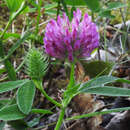Associations
provided by BioImages, the virtual fieldguide, UK
Foodplant / internal feeder
larva of Apion assimile feeds within inflorescence of Trifolium medium
Foodplant / internal feeder
larva of Apion trifolii feeds within inflorescence of Trifolium medium
In Great Britain and/or Ireland:
Plant / associate
adult of Bruchidius varius is associated with Trifolium medium
Remarks: season: (late 7-early 10, late 4)5-6
Other: major host/prey
Foodplant / parasite
conidial anamorph of Erysiphe trifolii parasitises live Trifolium medium
Foodplant / spot causer
amphigenous pseudothecium of Mycosphaerella carinthiaca causes spots on live leaf of Trifolium medium
Remarks: season: 4-5
Foodplant / parasite
sporangium of Peronospora trifoliorum parasitises live Trifolium medium
Other: major host/prey
Foodplant / spot causer
mostly hypophyllous colony of Ramularia anamorph of Ramularia sphaeroidea causes spots on leaf of Trifolium medium
Foodplant / parasite
hypophyllous telium of Uromyces fallens parasitises live leaf of Trifolium medium
Remarks: Other: uncertain
Physical Description
provided by USDA PLANTS text
Perennial, Herbs, Plants with rhizomes or sucke rs, Nodules present, Stems erect or ascending, Stems less than 1 m tall, Stems solid, Stems or young twigs glabrous or sparsely glabrate, Stems or young twigs sparsely to densely hairy, Leaves alternate, Leaves petiolate, Stipules conspicuous, Stipules green, triangulate to lanceolate or foliaceous, Stipules persistent, Stipules clasping stem at the base, Stipules adnate to petiole, Leaves compound, Leaves palmately 2-3 foliate, Leaflets dentate or denticulate, Leaflets 3, Leaves glabrous or nearly so, Inflorescences racemes, Inflorescences globose heads, capitate or subcapitate, Inflorescence axillary, Bracteoles present, Flowers zygomorphic, Calyx 5-lobed, Calyx glabrous, Petals separate, Corolla papilionaceous, Petals clawed, Petals red, Petals blue, lavander to purple, or violet, Banner petal narrow or oblanceolate, Wing petals narrow, oblanceolate to oblong, Wing petals auriculate, Wing tips obtuse or rounded, Keel tips obtuse or rounded, not beaked, Stamens 9-10, Stam ens diadelphous, 9 united, 1 free, Filaments glabrous, Style terete, Fruit a legume, Fruit unilocular, Fruit freely dehiscent, Fruit oblong or ellipsoidal, Fruit orbicular to subglobose, Fruit or valves persistent on stem, Fruit enclosed in calyx, Fruit glabrous or glabrate, Fruit 1-seeded, Seeds cordiform, mit-shaped, notched at one end, Seed surface smooth, Seeds olive, brown, or black.
Trifolium medium: Brief Summary
provided by wikipedia EN
Trifolium medium, the zigzag clover, is a flowering plant species in the bean family Fabaceae. It is similar in appearance to red clover, Trifolium pratense, but the leaflets are narrower and have no white markings and the narrow stipules are not bristle-pointed.: 150 The species is native to Europe from Britain to the Caucasus.
- license
- cc-by-sa-3.0
- copyright
- Wikipedia authors and editors

